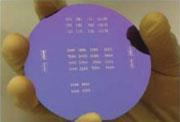Printed carbon nanotube transistors could prove to be a cheaper way to control LEDs in flatscreen displays
Researchers in California have developed a way to print transistors made of carbon nanotubes and have used them to turn an organic light emitting diode (OLED) on and off. According to the researchers, printed carbon nanotube (CNT) transistors would be cheaper than their silicon counterparts and an effective control system for printed LED displays.

Teams around the world are developing methods for printing OLEDs, transistors and other circuitry onto stiff or flexible backings. Although the transistors developed by Kosmas Galatsis of Aneeve Nanotechnologies in Los Angeles and colleagues don’t break any records for performance, they demonstrate that OLEDs can be controlled by a printed CNT transistor.
To make the transistors, the team first printed silver source, drain and gate electrodes onto SiO2. They then printed a solution of 98 per cent single-walled CNTs between the source and drain electrodes. Once the CNTs were dry, they added another layer of silver to create a back-gated transistor.
If the gate electrode is sufficiently positive its electric field, transmitted via the SiO2, forces the electrons in the CNTs out of the conduction band - they won’t pass a current between the source and drain electrodes, so any attached LED is off. But if the gate electrode is negative, its field pulls electrons into the conduction band so that they move freely, powering the LED.
The team added a layer of polyethylenimine with LiClO4 to the top of the CNTs, making the transistor top-gated. Because the polymer gets into the ’nooks and crannies’ of the printed CNTs, Galatsis says that its electric field has a stronger effect on the CNTs, offering better control over the current through the transistor.
Esko Kauppinen, a CNT electronics researcher at Aalto University, Finland, points out that in the study, top-gating the CNTs actually cut down one of their main advantages - a high electron mobility, which allows them to support larger currents. The back-gated transistors have an electron mobility more than 40 times greater than the top-gated ones.
Galatsis acknowledges this, but he says that the team’s latest efforts, with an improved polymer gate, are the ’world’s best’ for fully printed CNT transistors. The details of the polymer are another part of the transistor’s ’secret recipe’.
However, Kauppinen says that industry is likely to prefer the faster gravure method, which patterns ink onto a roll or plate and then transfers it to the substrate. Galatsis agrees, but he believes that his team’s process could be modified for this approach. If a company bought their method tomorrow, he says, printed CNT transistors could be in commercial production inside two years.
Kate McAlpine
References
P Chen et al,Nano Lett., 2011, DOI: 101021/nl202765b






No comments yet